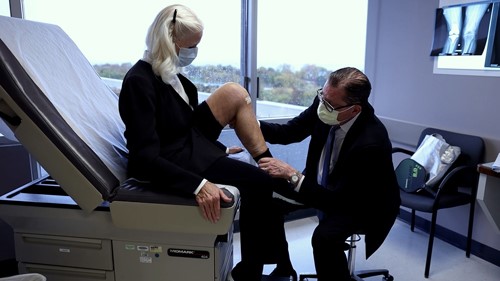An advanced robotic-assisted device offers enhanced benefits to people needing a total knee replacement or partial knee replacement. The benefits include smaller incisions, decreased blood loss and a more rapid recovery.
Meet Susan Cusack, 75, an avid pickleball player from suburban Chicago
Susan is among the first patients to get her knee replaced with the assistance of this next generation of robotics. It is her second such surgery in two years. In 2018, she underwent knee replacement in her right knee after her arthritic, bone-on-bone knee gave out on the pickleball court. In late summer 2020, the same thing happened in her left knee. “Again, I heard a loud crunch and immediately had a good deal of pain,” she said.
Mrs. Cusack called her surgeon, Henry Finn M.D., medical director of the Chicago Center for Orthopedics & Robotic-Assisted Surgery and Professor of Orthopedic Surgery at the University of Chicago. She was excited to learn he would be using this new technology to replace her other knee.
“It’s a fascinating area of surgery right now,” Mrs. Cusack noted. “Dr. Finn explained to me how the technology was being used for greater precision in cutting the bone to more properly fit the implant. I was all in.”
Dr. Finn said, “Mrs. Cusack was an excellent candidate for this robotics-assisted approach. Given her level of activity, we believed that it would allow her to recover sooner, function better and increase the longevity of the implant.”
Dr. Finn performed the first hand-held robotics-assisted total knee replacement in Illinois using the CORI Surgical System in mid-2020. “This system enables me to provide my patients with the ultimate knee replacement experience. It’s not a robot doing the surgery but literally puts the robotic technology in the palm of my hand, giving me another level of precision during surgery.”
CORI stands for Core of Real Intelligence. It is the most advanced and efficient hand-held robotic technology for knee replacement in the world. Instead of requiring a costly and time-consuming CT scan or an MRI prior to surgery as with first generation robotic systems, it allows surgeons to create a customized 3D digital model of each patient’s knee. The model is used to determine where the implant should be placed based on the patient’s unique anatomy, providing optimal function of the implant and making it possible for patients to have a faster recovery.
Mrs. Cusack had her surgery in late September. “I had surgery on a Thursday, and I was thrilled to go home the next day,” she said. “Two years ago, with my right knee replacement, I had surgery on a Tuesday and didn’t leave the hospital until Friday. So, there was a big difference.” Especially at a time when COVID-19 was a concern, Mrs. Cusack appreciated being able to go home as soon as possible following surgery.
Dr. Finn says using this advanced technology also makes same-day knee replacement surgery possible depending on a patient’s age, medical conditions and overall health, home support, motivation, and ability to receive outpatient physical therapy.
According to the Agency for Healthcare Research and Quality, nearly 800,000 knee replacements are performed each year in the United States. The American Academy of Orthopedic Surgeons estimates knee replacement surgeries are expected to increase a staggering 180% between now and 2030.
Ms. Cusack has recovered well. “I love to go on long hikes and walks when I travel and be involved with my grandchildren, along with playing pickleball, so having my knees replaced has allowed me to continue living my life the way I want to live it.”
If you have knee or hip pain and want to discuss surgical or non-surgical interventions, please call 773-564-7770.

